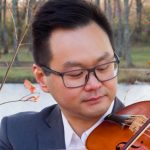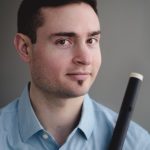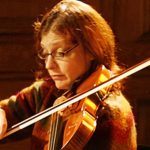We’ve waited two years to bring you this exquisite collaboration between the Sebastians and choreographer Christopher Caines—enjoy the most beautiful movement and music together, with newly commissioned choreography by Christopher Caines Dance and dance suites by Bach.
I am thrilled to welcome you to our long-awaited season finale, featuring three newly commissioned ballets by Christopher Caines. I first met Christopher when we worked together on dell‘Arte Opera Ensemble‘s 2015 production of Purcell’s The Fairy Queen. I was struck by Christopher’s direction and choreography—not only his creativity and passion, but by the depths of musical knowledge and research he brought to his conception of that piece. When we had the idea to commission a new dance work for the Sebastians, he immediately came to mind.
Though Bach certainly didn’t intend his music to be danced, he was inspired by the fashionable dance suite of the baroque. He was a leading proponent of the form, and he knew all of the physical dances themselves. Though Bach never left Germany, he was intimately familiar with the French “suite.”
Bach’s suites for solo cello are some of the most popular in the whole canon of classical music. Today you will hear the final suite, which takes advantage of the five strings of the violoncello da spalla. Of all Bach’s cello suites, this one seems to show the most inventiveness in Bach’s use of the dance forms, containing more virtuosic passagework and improvisatory moments. The famed 20th-century cellist Mstislav Rostropovich called this suite “a symphony for solo cello.”
From the first set of suites that Bach composed—the so-called “English”—Bach’s absorption of the French style were clear. After the lengthy prélude, filled with Bach’s signature busy counterpoint and structure, the only departure from a bog-standard French suite is the insertion of the pair of passepieds (the “pass-foot,” implying their fleetfooted nature) before the chromatic gigue.
The second Orchestral Suite is probably a reworking of an earlier work, possibly with a solo violin or oboe instead of the solo flute. The only movement utilizing the whole range of the flute is the variation (“double”) of the polonaise, implying that perhaps the double was newly composed for this version. The only “normal” French dances Bach includes are the Sarabande and the Menuet—interestingly, the only movements where the flute and first violin double each other throughout.
We are so excited to share not just these amazing works by our namesake with you, but also the stunning new ballets created by Christopher Caines. Christopher’s choreography is rooted in classical ballet, but his movement vocabulary is wide ranging. Dance with Bach incorporates elements from flamenco, tango, Hindu bharatanatyam, Scottish traditional, and even a bit of baroque dance, all intricately interwoven with Bach’s musical motifs and structures.
Joining the dancers of Christopher Caines Dance and the Sebastians on stage will be seven talented young girls, aged nine to thirteen, from the New York Theatre Ballet School!
Program
Download Concert Program (4 MB)
Jean Marie Leclair (1697–1764)
Ouverture
Johann Sebastian Bach (1685–1750)
Cello Suite no. 6 in D major, BWV 1012, for violoncello (da spalla), with dancers
English Suite no. 5 in E minor, BWV 810 for harpsichord, with dancers
Suite no. 2 in B minor, BWV 1067 for flute, strings, and continuo, with dancers
Choreography by CHRISTOPHER CAINES
Costume design by MICHAEL CAINES
DANCERS
Michael Bishop • Elisa Toro • Franky Genaro Freire
Jeremy Kyle • Michelle Vargo • Leigh Schanfein
with dancers from NEW YORK THEATRE BALLET SCHOOL
Charlotte Anub • Audrey Cen • Josephine Ernst
Madeline Goodwin • Clara Rodrigues-Cheung
Emely Leon Rivas • Eva Sgorbati
Safety and COVID-19
The safety of our performers, staff, and audience are of the utmost importance to us. As the COVID-19 pandemic continues to evolve, we will closely monitor local conditions as concerts date draw near. We reserve the right to require proof of vaccination, masking, and distance inside the concert hall. We will announce our safety procedures for each concert in advance of the performance date.
By purchasing a ticket and attending a concert, you acknowledge that despite all reasonable precautions, there are risks in attending live musical events and you agree to accept those risks yourself. You release the Sebastians (legally, Sebastian Chamber Players, Inc.) from any claims based on your attendance of one of our concerts. Your in-person concert ticket grants you access to the virtual concert experience—available shortly after the performance. If you have any questions or need assistance, we are always reachable at music@sebastians.org.








